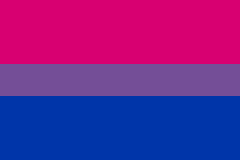Bisexual lighting

Bisexual lighting is the simultaneous use of pink, purple, and blue lighting to represent bisexual characters. It has been used in nightclubs as well as supposedly in studio lighting for film and television.[1]
Meaning
George Pierpoint of BBC News writes that bisexual lighting has been used as an "empowering visual device" which counteracts perceived under-representation of bisexuality in the visual media. The colours may be a direct reference to the bisexual pride flag.[2][3] The trend gained traction in the LGBT community in 2017 particularly on social media sites Twitter, Reddit, and Pinterest.[4] Sasha Geffen wrote at Vulture.com that it had become "solid in its meaning",[5] while Nicky Idika of PopBuzz wrote that it has now "become an established part of bisexual storytelling in media".[6] Pantone selected "Ultra Violet" as the colour of 2018 in a move the BBC says reflected the growing use of the scheme.[2]
Use
According to Pierpoint, the visual aesthetic may have been used as early as 2014 in the television series Sherlock, referencing the speculated hidden desires of Dr. Watson.[2] The lighting has been used in numerous television and film media. The Hollywood films The Neon Demon, Atomic Blonde, and Black Panther all feature the use of blue, pink, and purple lighting. Similarly, the award-winning Black Mirror episode "San Junipero" made use of the visual aesthetic.[7]
Bisexual lighting also features in the music videos of Janelle Monáe's "bi anthem" "Make Me Feel" and Demi Lovato's "Cool for the Summer".[1]
Criticism
Amelia Perrin has criticized the trend of using such lighting when bisexual characters appear in television and music videos, arguing in Cosmopolitan that this visual image "perpetuates bisexual stereotypes". Perrin argues that this kind of lighting is usually produced by neon lights, which suggest "clubs and dancefloors" to the viewer, and this implies that "bisexual hook-ups and relationships are merely 'experiments', and something that only happens when you’re drunk on a night out."[1]
Lara Thompson, a lecturer of film at Middlesex University, has argued that bisexual lighting is not well-known, stating: "I would have to see more examples before I see bisexual lighting as a wholly convincing phenomenon".[2]
References
- 1 2 3 Perrin, Amelia (20 March 2018). ""Sure, bisexual lighting looks cool, but it can be problematic"". Cosmopolitan. Retrieved 22 April 2018.
- 1 2 3 4 Pierpoint, George (22 April 2018). "Is 'bisexual lighting' a new cinematic phenomenon?". BBC News. Retrieved 22 April 2018.
- ↑ Bruton, Louise (April 27, 2018). "JANELLE MONÁE Dirty Computer Wondaland/Bad Boy/Atlantic". The Irish Times. Retrieved May 2, 2018 – via HighBeam. (Subscription required (help)).
- ↑ David, Sara (23 February 2018). "Fortify Yourself with the Beauty of Bisexual Lighting". Vice. Retrieved 22 April 2018.
- ↑ Geffen, Sasha (23 February 2018). "Janelle Monáe Steps Into Her Bisexual Lighting". Vulture.com. Retrieved 22 April 2018.
- ↑ Idika, Nicky (26 February 2018). "You Definitely Never Noticed The Bisexual Lighting Aesthetic...Until Now". PopBuzz. Retrieved 22 April 2018.
- ↑ Jackman, Josh (28 February 2018). "Bisexual lighting is your new favourite viral meme". PinkNews. Retrieved 22 April 2018.